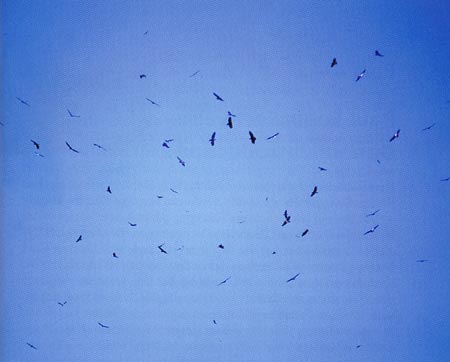Bald Eagles and Bird Strikes
Until the first two incidents, my cumulative knowledge of these magnificent raptors was limited to that gleaned from a Port Hardy cabbie: They reach maturity at five years, acquiring the characteristic white head and tail feathers. They mate for life.
In order to answer my question of their aggressive behaviour towards aircraft, I had to search out higher authority. David Hancock, the renowned B.C. biologist, proved the ideal resource. His doctorate thesis at U.B.C. studied the nesting habits of this bird. He is the author of “The Bald Eagle of Alaska, B.C. and Washington”. He has dedicated 50 years to the study of its nesting ritual and migratory routes. In this reader friendly publication he summarizes the results of his research, sprinkled with personal vignettes and spectacular photographs. My knowledge base expanded exponentially.
The bald eagle can be described as a gregarious scavenger with a passion for travel. One fall morning David enumerated 1460 eagles on the banks of the Harrison River - gathered to feast on the spent salmon carcasses. During the course of the day, there was a progressive thermal ascent to 3-5000 feet. Intriguingly, one third drifted south towards the Skagit River in Washington State, another third westward towards Surrey and Boundary Bay and the last group climbed higher disappearing over the mountains towards Squamish. It is a sobering thought - 1000 eagles soaring through the air space adjacent to Chilliwack, Abbotsford, Pitt Meadows, Langley, Boundary Bay and Vancouver Airports! A pilot encountering this soaring gaggle of eagles would be hard-pressed to escape unscathed - eagle roulette!
A recent research project of the U.S. Fisheries and Wildlife Services, with eagles wearing backpack transmitters and GPS tracking followed the movements of an adult pair in the Skagit River Valley of Washington State. The day after chick abandonment the female was plotted north to Surrey, BC, east along the US border to Alberta and north to Lesser Slave Lake. The distance covered in one day was a phenomenal 500 miles! The male headed north and by the third day was in Prince Rupert - averaging a paltry 200 miles per day. With this in mind, it is quite possible that a single rogue bald eagle could patrol the 10-15 miles between Hatzic and Stave Lakes. In my discussion with David he could not recollect an aggressive encounter with a bald eagle on his fixed wing aircraft. This takes into account his 1500 hours as a private fixed wing pilot, many in close quarters with “Baldy” while surveying nests.
